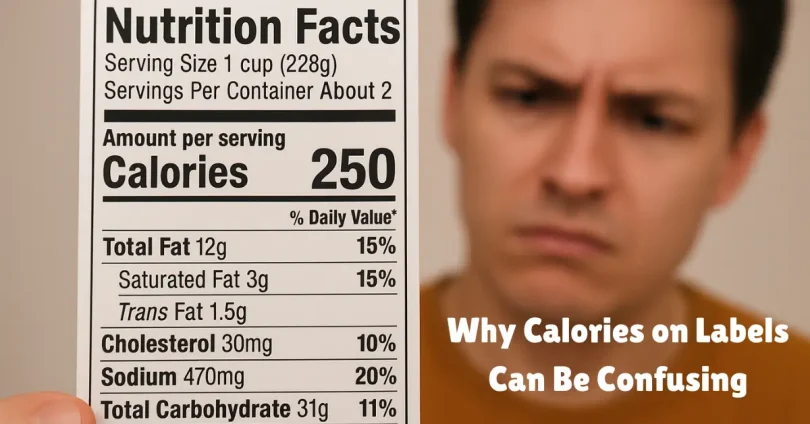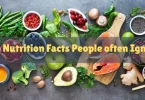In today’s health-conscious world, checking calories on food labels has become second nature for many people. Whether you’re trying to lose weight, maintain a healthy lifestyle, or manage a medical condition like diabetes, understanding why calories on labels can be confusing is essential. At first glance, calorie information seems straightforward—you see a number, and you assume it tells you exactly how much energy you’re consuming.
But in reality, calorie labeling involves a range of complexities, from standardized serving sizes and rounding rules to hidden ingredients and variations in food preparation. Knowing these nuances can help you make better, more informed decisions about the foods you eat every day.
1. Understanding Calories: What They Really Mean

Calories are a measure of energy. Specifically, a calorie (technically a kilocalorie on food labels) represents the amount of energy your body can obtain from consuming a particular food or drink. While it sounds simple, calories are far from uniform in how they impact your body:
- Calories vary by nutrient type: The body metabolizes fats, carbohydrates, and proteins differently. For example, 100 calories from sugar is processed rapidly and can spike blood sugar levels, whereas 100 calories from almonds provides protein, fiber, and healthy fats, which are absorbed more slowly and keep you full longer.
- Calories are averages: The calorie content listed on labels is often calculated in a lab using average values. The actual energy your body absorbs can vary depending on your digestive efficiency, metabolism, and even how the food is prepared. For example, roasted vs. raw vegetables might have slightly different caloric availability.
- Metabolic effects: Foods that are high in protein or fiber require more energy for digestion (the thermic effect of food), meaning your body uses some of the calories just to process them.
Because of these factors, the number on the label is a rough guide, not an exact measure of energy your body will receive.
2. Serving Sizes: The Hidden Source of Confusion
One of the biggest sources of misunderstanding about calories is serving size.
- Standardized serving sizes can mislead: Food labels are required to show calories per serving, but what counts as a serving may be much smaller than what people typically eat. For example, a bag of chips may list 150 calories per serving, but a single bag often contains 2–3 servings. If you eat the whole bag, you’re consuming 300–450 calories instead of the 150 listed.
- Real-life portions vs. label portions: Many consumers underestimate how much they actually consume. Breakfast cereals, beverages, and snack foods are particularly prone to this misjudgment.
Understanding the difference between labeled servings and actual portions is critical for accurately tracking calorie intake.
You may also like to read this:
13 Best Healthy Alternatives To Processed Meals For Everyone
Top Processed Food Brands In The Market Leading Innovation
What Nutrition Facts Mean on Food Labels – Complete Guide
How To Read Nutrition Facts Properly: Full Guide
Types of Hidden Ingredients In Processed Foods You Must Know
3. Rounding and Estimation on Labels
Calorie numbers on food labels are not precise; they are rounded according to regulatory guidelines:
- FDA rounding rules: Labels may round calories to the nearest 5 or 10 calories. A food item with 97 calories might be listed as 100, and one with 203 calories might appear as 200.
- Impact over multiple servings: Rounding errors might seem minor, but they can accumulate over multiple servings throughout the day. This explains why two people eating the same foods could absorb slightly different total calories even if their labels are identical.
Relying strictly on the number can therefore mislead you about your true energy intake.
4. Hidden Calories in Ingredients
Another confusing factor is that many ingredients contribute calories without being obvious:
- Added sugars and oils: Condiments, sauces, salad dressings, and snacks often contain hidden sugars and oils that increase calories substantially. A “healthy” salad can easily contain 300–400 calories if it’s topped with a heavy dressing or fried toppings.
- Low-fat products: Many “low-fat” items replace fat with sugar or refined carbohydrates to maintain taste, which can make the calorie content comparable—or even higher—than the original product.
- Consumer perception: People who focus only on calories may overlook these hidden sources, inadvertently consuming more energy than they think.
5. Variations in Food Preparation

Calories can differ depending on how a food is prepared:
- Cooking methods matter: Frying, roasting, or sautéing foods with oil increases calorie content, while boiling or steaming typically doesn’t. For example, grilled chicken may have fewer calories than fried chicken of the same weight due to oil absorption.
- Packaged food averages: Lab-tested calorie counts represent an average, but slight variations in ingredients, moisture content, and cooking processes can alter actual calorie content.
This is why two seemingly identical meals might not provide the same energy.
6. The Thermic Effect of Food (TEF)
Not all calories are absorbed equally. The thermic effect of food (TEF) is the energy your body expends to digest, absorb, and metabolize nutrients:
- Protein has the highest TEF: Your body burns roughly 20–30% of protein calories during digestion, compared to 5–10% for carbs and 0–3% for fats.
- Calorie labels don’t reflect TEF: This means that two foods with the same calorie count could result in different net energy gain in your body.
Considering TEF helps explain why the energy impact of foods differs even when labels show identical calories.
7. Misleading Marketing Terms
Marketing language can also make calorie interpretation tricky:
- “Light,” “low-fat,” and “reduced-calorie” labels may give a false sense of security. These foods are not always lower in calories when you consider serving sizes and added ingredients.
- “Natural” or “organic” foods are often perceived as healthier, but that doesn’t necessarily mean they are lower in calories. A sugar-free organic cookie can still be calorie-dense.
Consumers should look beyond marketing claims and focus on the actual nutrition information.
8. Practical Tips for Navigating Calorie Labels
To make informed choices despite these challenges:
- Check serving sizes: Compare the label’s serving size to what you actually eat.
- Read ingredient lists: Watch for hidden sugars, oils, and calorie-dense additives.
- Understand macronutrients: Protein, fat, and carbohydrate calories impact your body differently.
- Use calories as a guideline, not a rule: Treat them as estimates rather than exact measurements.
- Prefer whole foods: Whole, minimally processed foods have more predictable calorie content and nutritional value.
- Consider preparation methods: Cooking can significantly alter calories, so adjust estimates accordingly.
Conclusion
Understanding why calories on labels can be confusing is crucial for making smarter, healthier food choices. Serving sizes, rounding rules, hidden ingredients, preparation methods, and marketing claims all play a role in how calorie information is presented.
By being aware of these nuances, reading ingredient lists carefully, and combining calorie awareness with portion control, you can navigate labels more confidently, manage your energy intake effectively, and develop a healthier relationship with food. Calories on labels are helpful guides, but informed choices require looking beyond the numbers.
FAQs
1. Why are calories on food labels often inaccurate?
Calories on labels are averages calculated in labs. They are rounded and don’t account for variations in ingredients, preparation methods, or individual digestion, which can make them slightly different from the actual energy your body absorbs.
2. How do serving sizes affect calorie information?
Serving sizes on labels are standardized and often smaller than what people actually eat. Eating more than the listed serving can lead to consuming significantly more calories than expected.
3. Are all calories the same?
No. Calories from fats, carbohydrates, and proteins affect your body differently. For example, calories from protein require more energy to digest than calories from sugar, impacting how your body uses them.
4. Can cooking methods change calorie content?
Yes. Frying, sautéing, or roasting with oil adds calories, while boiling or steaming usually doesn’t. Even packaged foods can have slight variations depending on preparation and moisture content.
5. What are hidden calories?
Hidden calories come from added sugars, oils, sauces, and other ingredients that increase energy content without being obvious. Low-fat or “diet” foods can also contain hidden sugars that raise calorie counts.




